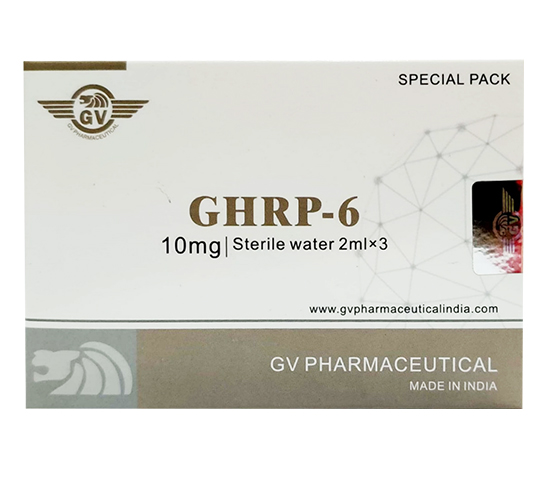GHRP-6 DESCRIPTION
GHRP-6 peptide (Growth hormone-releasing peptide-6) is synthetic analogue of endogenous opioid peptide met-enkephalin, includes unnatural D-amino acids, and belongs to the growth hormone secretagogues group and its ghrelin receptor agonists subgroup. Growth hormone secretagogues (GHS) lack opioid activity but are powerful stimulants of growth hormone production. Simultaneously GHS are distinct from growth hormone releasing hormone (GHRH) in that they share no sequence relation and derive their function through activation of a completely different receptor – growth hormone secretagogue receptor (GHSR; or often called simple as ghrelin receptor). Natural endogenous ligand of Growth hormone secretagogue receptors is endogenous hormone Ghrelin. All ghrelin receptor agonists (incl. GHRP-6 peptide) act as synthetic ghrelin mimetics. GHRP-6 peptide is structurally very similar to its predecessor GHRP-2 peptide.
GHRELIN
Ghrelin (often called also as a “hunger hormone”) is endogenous hormone produced by enteroendocrine cells of the gastrointestinal tract, especially the stomach. Blood levels of ghrelin are highest before meals when hungry, and low after mealtimes. Ghrelin helps prepare for food intake by increasing gastric motility and gastric acid secretion. But Ghrelin also activates cells in the anterior pituitary gland and hypothalamic arcuate nucleus (including neuropeptide Y neurons that initiate appetite). Ghrelin binds to specific receptor – the growth hormone secretagogue receptor 1A (GHSR-1A), and stimulate GH secretion, but also is involved in other important functions – regulation of reward cognition, learning and memory, the sleep-wake cycle, taste sensation, reward behavior, and glucose metabolism.
GROWTH HORMONE SECRETAGOGUE RECEPTOR
The ghrelin receptor GHSR-1A (a splice-variant of the growth hormone secretagogue receptor, with the GHS-R1b splice being inactive) is involved in mediating a wide variety of biological effects of ghrelin, such as: stimulation of growth hormone release, increase in hunger, modulation of glucose and lipid metabolism, regulation of gastrointestinal motility and secretion, protection of neuronal and cardiovascular cells, and regulation of immune function. They are present in high density in the hypothalamus and pituitary, on the vagus nerve (on both afferent cell bodies and efferent nerve endings) and throughout the gastrointestinal tract.
GHRP-6 RESULTS OF ACTION
GHRP-6 is highly effective in increasing blood levels of HGH and IGF-1. Due to its properties, it is a promising candidate for the treatment of growth hormone deficiency, cachexia (wasting), eating disorders and obesity. Early studies translated into a new research era that inserted synthetic GHRPs also as promising cardio and cytoprotective candidates. A broad safety profile and a successful preclinical pharmacology nurtured the enthusiasm for GHRP-6 as a myocardial reperfusion damages-attenuating candidate. The existence of efficacious although occasional and fragmented clinical interventions in life-threatening conditions, along with the GHRP-6 multifactorial mechanism of action in myocardial infarction, ignite the initiative for a coherent clinical development.
SCIENTIFICALLY INVESTIGATED POSSIBLE BENEFITS OF GHRP-6
-
- Improved overall regeneration
- Anti-aging and rejuvenating effects
- Improved vitality, freshness
- Increased collagen production, healthier skin
- Increase in muscle mass and performance
- Reduction of excess body fat
- Improved sleep
- Ability reduce risk of heart & cardio-vascular diseases
- Strengthened immune system
GHRP-6 POSSIBLE SIDE-EFFECTS
-
- May increased appetite, altered feeling of hunger
- Skin reactions at the injection site such as pain, redness and swelling
- May reduced insulin sensitivity
- Dizziness rarely
GIVE YOUR REVIEW ( Your email address will remain unpublished )
100% LAB TESTED PRODUCTS
GUARANTEED PURITY AND EFFECTIVENESS


Lorem ipsum dolor sit amet, consectetur adipisicing elit, sed do eiusmod tempor incididunt ut labore et dolore magna aliqua. Ut enim ad minim veniam, quis nostrud exercitation ullamco laboris nisi ut aliquip ex ea commodo consequat.
Lorem ipsum dolor sit amet, consectetur adipisicing elit, sed do eiusmod tempor incididunt ut labore et dolore magna aliqua. Ut enim ad minim veniam, quis nostrud exercitation ullamco laboris nisi ut aliquip ex ea commodo consequat.